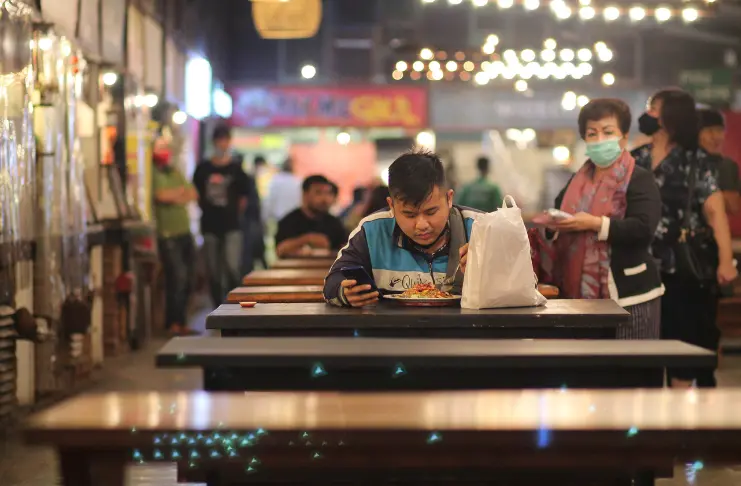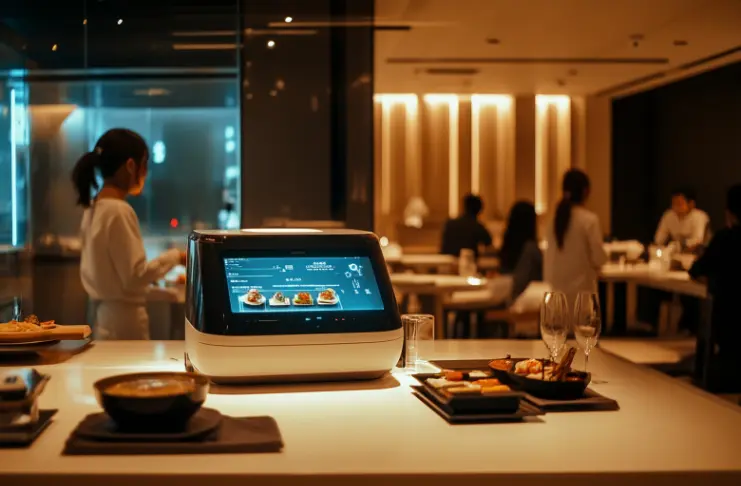
A walk through any Filipino city reveals the complexity of its restaurant industry. In Metro Manila, digital ordering and self-service kiosks are reshaping fast-food service, while in places like Iloilo or Davao, restaurants serve as cultural touchpoints, offering local flavors with growing tourist interest.
These contrasts define how foodservice in the Philippines is evolving: increasingly influenced by digital habits, regional demand, and consumer price sensitivity.
In such a market, the growth depends on how well businesses can adapt to uneven infrastructure, shifting spending behavior, and rising operational costs. This blog examines the growth of the Philippine restaurant sector, the formats and behaviors driving it, and the key Philippine restaurant industry statistics operators need to understand before making their next move.
Philippine Restaurant Industry Statistics: Market Size and Segmentation
1. Overall Market Size
The Philippine restaurant industry is experiencing strong and sustained growth, supported by rising consumer demand, expanding delivery infrastructure, and regional diversification.
The Philippine food service market is currently valued at $18.41 billion, with projections to reach $36.27 billion at a 14.52% CAGR by 2030. This growth is attributed to factors such as macroeconomic stability and the pace of infrastructure improvements across regions.
2. Segmentation by Service Format
2.1 Quick-Service Restaurants
As of 2023, the Philippine chain restaurant market was valued at approximately $10 billion, with projections suggesting it could reach $42.2 billion by 2032, reflecting a compound annual growth rate (CAGR) of 17.8%. These numbers highlight the expanding footprint of quick-service outlets and the adoption of digital ordering models across the country.
QSRs lead the formal restaurant sector in the Philippines with a projected value of $10.2 billion by 2032 at a CAGR of 4.71%. These establishments benefit from standardized menus, low average ticket sizes, and compatibility with delivery platforms, resonating with the country’s cost-conscious middle class.
As a result of rising demand for convenience, QSR chains are rapidly expanding in urban and semi-urban areas, often utilizing kiosk models and quick dine-in services to attract consumers.
2.2 Full-Service Restaurants
While FSRs are more operationally intensive, they are popular among higher-income groups, tourists, and occasion-driven diners. The format contributes significantly to foodservice revenue in the Philippines, with the average order value rising at a growth rate of 3.8% since 2022.
What’s interesting is that the FSR segment is evolving beyond high-quality dining to hybrid models and global cuisine to cater to a diverse and ever-evolving consumer.

2.3 Cloud Kitchens
Cloud kitchens are the fastest-growing service format in the Philippine foodservice space, projected to expand at a CAGR of 26.1% between 2024 and 2032. Their low capital requirements and delivery-first model allow restaurant owners to rapidly expand in locations with minimal infrastructure.
These kitchens are particularly active in metro areas, serving multiple cuisine brands from centralized hubs.
Operators often run multiple digital brands under one roof to maximize kitchen utilization. The segment is also seeing increased interest from franchisees and small investors drawn to the lower break-even point.
2.4 Food Delivery
The food delivery segment is a core part of the Philippine foodservice industry. Platforms such as GrabFood and Foodpanda are now crucial to the growth of both chain and independent restaurants, especially in urban and tier-2 cities.
In 2024, the digital food delivery services market reached approximately $3.86 billion, and it is expected to grow at a CAGR of 12.3% through 2034, hitting around $12.3 billion.
This expansion is driven by smartphone penetration, a growing preference for digital payments, and the need for convenient dining among urban consumers.
Growth Trends Driving the Philippine Restaurant Industry
1. Macro Drivers: Rising Income, Urbanization, and Dining Culture
Rapid urban migration and increasing disposable income are reshaping Filipino eating habits. Between 2022 and 2030, the overall foodservice market is projected to climb from $20.5 billion to $30.5 billion, growing at a CAGR of ~4%, a reflection of both economic growth and evolving consumption patterns.
In cities like Manila, Cebu, and Davao, households with time constraints and higher spending power are dining out more often; the average spend per dining experience is 500 PHP (or USD 8.75). There is a constant influx of new restaurants in these cities, with over 23,000 dining establishments in Manila alone and 1,500 new restaurants opening annually.
2. Expansion of Online Delivery
The Philippines is witnessing one of the fastest digital shifts in Southeast Asia, with delivery platforms changing how customers eat and get their meals.
For starters, user penetration in the online meal delivery market is expected to reach 18.7% by 2025. This growing dependency on online food delivery is prompting restaurants to re-evaluate their business models. A lot of the restaurants in the Philippines are adopting delivery-specific menus or investing in logistics and packaging that preserve quality over longer transport times.
Moreover, delivery has become a crucial entry point for new customer segments, especially in urban areas where dine-in competition is high and foot traffic is volatile. For small independents and virtual brands, visibility on delivery apps is now as critical as physical location was a decade ago.
As a result, even food aggregators have expanded their partnerships beyond big brands, allowing small independent restaurants to reach new customers. Cloud kitchens in the Philippines are also utilizing delivery apps to serve dense markets without the need for dine-in infrastructure.
3. Technology and Innovation
As the market grows competitive, Philippine restaurants are turning to automation to unlock efficiency and growth at scale. The shift is being driven by both consumer expectations and operational pressures, as consumers and owners seek speed, accuracy, and consistency in different formats.
This transformation is visible across multiple fronts. McDonald’s Philippines, for example, has rolled out over 30 NXTGEN outlets featuring self-order kiosks, cashless payments, and split counters for ordering and pickup, introducing a digitally assisted guest journey across locations in Taguig to regional hubs like Pampanga and Davao.
Meanwhile, cloud kitchens and digital-first operators are embedding standard tech tools, including Kitchen Display Systems (KDS), integrated POS synced with delivery platforms, and table-mounted QR ordering menus to manage multiple brands from a centralized kitchen, reduce order errors, and speed up throughput.

4. Health, Sustainability & Menu Innovation
The pandemic raised consumer interest in healthier meals, and Filipino restaurants have taken notice. In 2023, over 150 chain restaurants were offering plant-based menu items, while over 200 restaurants shifted to biodegradable packaging.
Clearly, sustainability is the new standard, as brands strive to adopt biodegradable packaging to appeal to eco-conscious consumers. Plus, restaurants that lean into healthy ingredients, clean sourcing, and eco-friendly processes not only earn premium pricing but also faster acceptance in urban hubs and among conscious diners.
5. Tourism & Culinary Experiences
Regional food tourism is emerging as a key sector driver. The culinary tourism market is currently valued at $5.4 billion (2024) and forecast to reach $16.7 billion by 2032, growing at a 15% CAGR. Metro Manila, Cebu, and Davao are primary growth engines, but secondary cities like Iloilo, which was recently recognized by UNESCO for its gastronomy, are also gaining traction.
This trend is prompting restaurants to focus on authenticity, regional identity, and digital visibility by offering regional menus and curated dining experiences.
EXPERT OPINION
Victor Lim, co-founder of Kraver’s Canteen, a cloud kitchen network in the Philippines, says, “The consumer interest in the model reached its peak during the pandemic as pretty much every F&B company was forced to act like a cloud kitchen during the crisis…The pandemic has allowed not only the cloud kitchen model to thrive but also created massive shifts in customer behaviour and the Filipino market. The growth of food deliveries, in general, as a segment — combined with the pandemic and the introduction of cloud kitchen concepts — came at a uniquely interesting time, where we are also seeing a rising, younger middle class that is growing more accustomed to digital commerce and online tendencies.” |
Challenges Facing the Philippine Restaurant Industry
1. Supply Chain Volatility and Rising Ingredient Price
Restaurants are navigating unpredictable costs driven by global supply shocks. In March 2024, rice prices surged by 24.4% annually, prompting the Philippine government to declare a “food security emergency” and release buffer stocks to stabilize costs. In parallel, restaurants reported ingredient costs doubling in some cases, directly influencing menu pricing and profitability.
2. Inflation and Consumer Price Sensitivity
Persistent inflation continues to pressure both operators and diners. As food prices, including key staples like rice and pork, increased sharply in 2023, many restaurant chains raised menu prices to offset losses while still attempting to retain foot traffic. This has led to consumers controlling their budgets while cost-to-serve grows.
3. Labor Shortages and High Turnover
Staffing remains a structural headache for the industry. High turnover rates and difficulty in sourcing skilled kitchen or front-of-house staff have prompted restaurants to offer higher wages and retention bonuses. These tactics have increased labor costs, contributing to operational strain even as service consistency declines.
4. Weak Local Sourcing Infrastructure
Despite efforts to encourage sustainability in dining and farm-to-table sourcing, the Philippine agricultural sector remains underdeveloped. Local restaurants are dealing with unreliable yields, seasonal disruption, and limited access to modern farming techniques, leading to dependency on imports. This further adds currency-related cost volatility. As a result, operators often face shortages of core inputs like vegetables, seafood, and dairy.
5. Operational Complexity in Multi-Channel Offerings
While online food delivery has been growing tremendously in the Philippines, managing multiple aggregator platforms opens up restaurant owners to logistical and pricing complexity. With digital ordering platforms accounting for a major portion of their orders for some chains, mishandling of menus, delivery delays, and high commission fees can severely eat into margins and hurt customer satisfaction.
Philippine Consumer Dining Trends and Preferences

As the Philippine food service sector evolves, consumer behavior is becoming more nuanced, shaped by convenience, lifestyle, costs, and digital exposure. Here are the key consumer trends and restaurant statistics Philippines defining the industry-
A. Consumer Spending and Behavior
- The Philippine food retail market grew by 8% in 2023, despite inflation, with a continued 5% growth forecast for 2024.
- Food and non-alcoholic beverages represent 32.6% of household consumption as of Q1 2025, indicating dining remains the top household expense.
- Diners in the Philippines spend between 80 – 130 PHP ($1.40- $2.30) on an average meal per person.
- As of 2025, 30% of Filipinos dine out at least once every day, 19% once a week, and 20% do so several times a month.
- Registered foodservice establishments grew by ~4.7% annually from 2015 to 2020 (from 151,000 to 190,000), signaling ongoing business expansion.
- The Consumer Price Index for Restaurants & Accommodation Services rose to 156.4 (2018=100) by March 2025, a steep increase from 139.6 in early 2024, indicating that consumers are paying over 12% more year-over-year to dine out.
B. Digital Ordering and Delivery
- Grab reports that 89% of users discover new restaurants via GrabFood, surpassing social media, referrals, and blogs.
- 87% of Filipinos snack via delivery between 3 pm and 6 pm, with snack baskets having the highest average order value of the day.
- Online food delivery revenue in the Philippines is expected to reach $5.11 billion in 2025 as over 70% consumers prefer delivery over traditional dine-in.
- The demand for online delivery is growing rapidly, with over 60 million food delivery app installs and 500,000 daily orders.
- Restaurant loyalty programs are popular among Philippine diners, with over 10 million members.
- Within the digital ordering landscape, cloud kitchens are establishing a strong presence with over 450 new delivery-only establishments and 150,000 delivery drivers.

C. Eating Preferences and Trends
- Before the pandemic, 47% of consumers in a survey preferred organic food, and 53% opted for non-organic food. However, the pandemic changed this sentiment, as 78% preferred organic food.
- Post-pandemic, daily cooking practices rose from 93% to 98% among Philippine consumers, showing growing health consciousness.
- According to a report by Rakuten Insights, fast food chains are highly popular in the Philippines, with 80% choosing them as their preferred dining option.
- 71% of Philippine consumers dine out of home for dinner.
- A Philippine study reveals that food quality and health measures highly influence consumers’ restaurant choices.
- 44% of Filipino consumers say they’re willing to pay more for sustainable brands, and 96% are more likely to support brands with eco-conscious practices, signaling growing social values around ethical consumption.
D. Social and Cultural Influences
- Social media drives rapid decision-making among Philippine consumers, as they highly engage with brand content and peer recommendations.
- 94% of users say they read reviews on the app, making peer feedback a critical trust signal influencing whether or where Filipino consumers dine out or order food.
- Dining out is a family occasion for many Philippine consumers, with 76% of people regularly dining out with their family.
Conclusion
The Philippine restaurant industry is evolving rapidly, shaped by digital adoption, rising consumer expectations, and shifting spending patterns. While challenges like inflation and labor shortage are affecting operations, new opportunities are emerging through local menus, tech adoption, and tourism-linked dining. As a result, staying on top of the latest statistics of restaurants in the Philippines is important to stay competitive in business.
Frequently Asked Questions
The Philippine foodservice sector is estimated at $18.4 billion in 2025, with projected growth to $36.3 billion by 2030 at a CAGR of ~14.5%.
The Philippine food service industry remains a key formal sector, comprising 30,861 establishments in 2022, according to the PSA. Of these, over 75% were restaurants and mobile food services, while the rest were bars or accommodation. These businesses accounted for nearly 99% of total paid employment in the accommodation and food sector, highlighting their significant economic footprint.
The services sector dominates the Philippine economy; within that, foodservice (which includes restaurants, catering, and mobile outlets) remains a fast-growing segment, contributing over PHP 300 billion to the economy and employing over 70% of workers in accommodation and F&B.
The Philippine food industry is undergoing significant growth due to digitalization, evolving consumer preferences, and market diversification. Cloud kitchens are scaling rapidly, quick service restaurants (QSRs) are gaining a dominant market share, and consumers are actively seeking healthy dining options.
Profitability in the Philippine restaurant industry varies significantly depending on scale, location, and operational efficiency. The industry typically aims for a net margin ranging between 10%-20%, but high overheads, rising food costs, and intense competition can impact profitability.
According to PSA’s 2022 Annual Survey of Philippine Business and Industry, there were 33,215 formal restaurant and mobile food service establishments, accounting for nearly 75% of the F&B sector.








